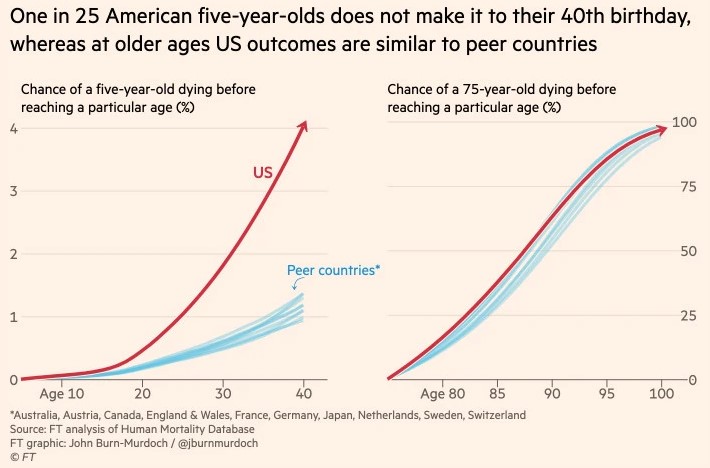
American kids’ life expectancy isn’t so bad, if all things are considered.
To what extent, do you think, is our current predicament caused by a feedback loop of blindness? Perhaps the people investigating society’s questions are actually incapable of considering some possibilities for ideological reasons. They therefore craft policies and advance cultural changes whose outcomes they cannot measure because of the blind spot with which they began.
A few days ago, John Burn-Murdoch sent ripples throughout social media with a Financial Times article titled, “Why are Americans dying so young?” (Putting the title in a search engine may provide you a link you can read without subscribing.) Burn-Murdoch doesn’t investigate the answer or even tally deaths by various causes. Rather, in the clickbait method of our day, he produces charts like the following:

The primary point to remember when viewing such charts is to check the axes. Yes, Burn-Murdoch shows American children to be four times more likely to have died by the age of 40, but that’s still only 4% of them. His other charts do similar things, such as cutting the vertical axis to make a couple years of longer life, on average, look like a 50% increase.
Such methods aren’t necessarily tricks; sometimes we do want to zoom in to spot differences. Magnitude is important to remember, however, when we’re seeking causes. The United States is incredibly diverse in just about every way it’s possible to be diverse — geography, demographics, wealth, etc. Comparing us to England or to a selected collection of “peer countries” might not be as appropriate as comparing us with a similarly sized area somewhere else on the planet. A few years of life or a few percentage points of difference are easy to make up by changing the dataset.
Such gaps are easy to make up in other ways, too. One factor that Burns-Murdoch does not consider, for example, is abortion. Data from Johnston’s Archive for the United States and the United Kingdom suggests that one in eight (12.4%) children conceived in the United States is aborted, compared with 1 in 4 (24.8%) in the United Kingdom. Start Burn-Murdoch’s clock at conception rather than the age of 5, and the picture is very different.
This isn’t only a point about the proper starting point of human life. A society’s comfort with killing children before they exit the womb will tend to eliminate those who might have faced challenges. Out of every 100 children conceived, the United States gives an extra 13 a chance at life. If only three of those would have been aborted in the United Kingdom because they tested positive for genetic problems or because their mothers were destitute and unlikely to raise them healthily, then the gap in the left chart above disappears.
Whether it is better for those children to live or to die before they’re self-aware is a cultural question for which we’ll have different answers. That said, investigators like Burn-Murdoch probably won’t even identify it as a relevant question as they’re compiling statistics to fault the United States for its health care system, gun laws, or some other cause of the day.
Featured image by Rene Bernal on Unsplash.
